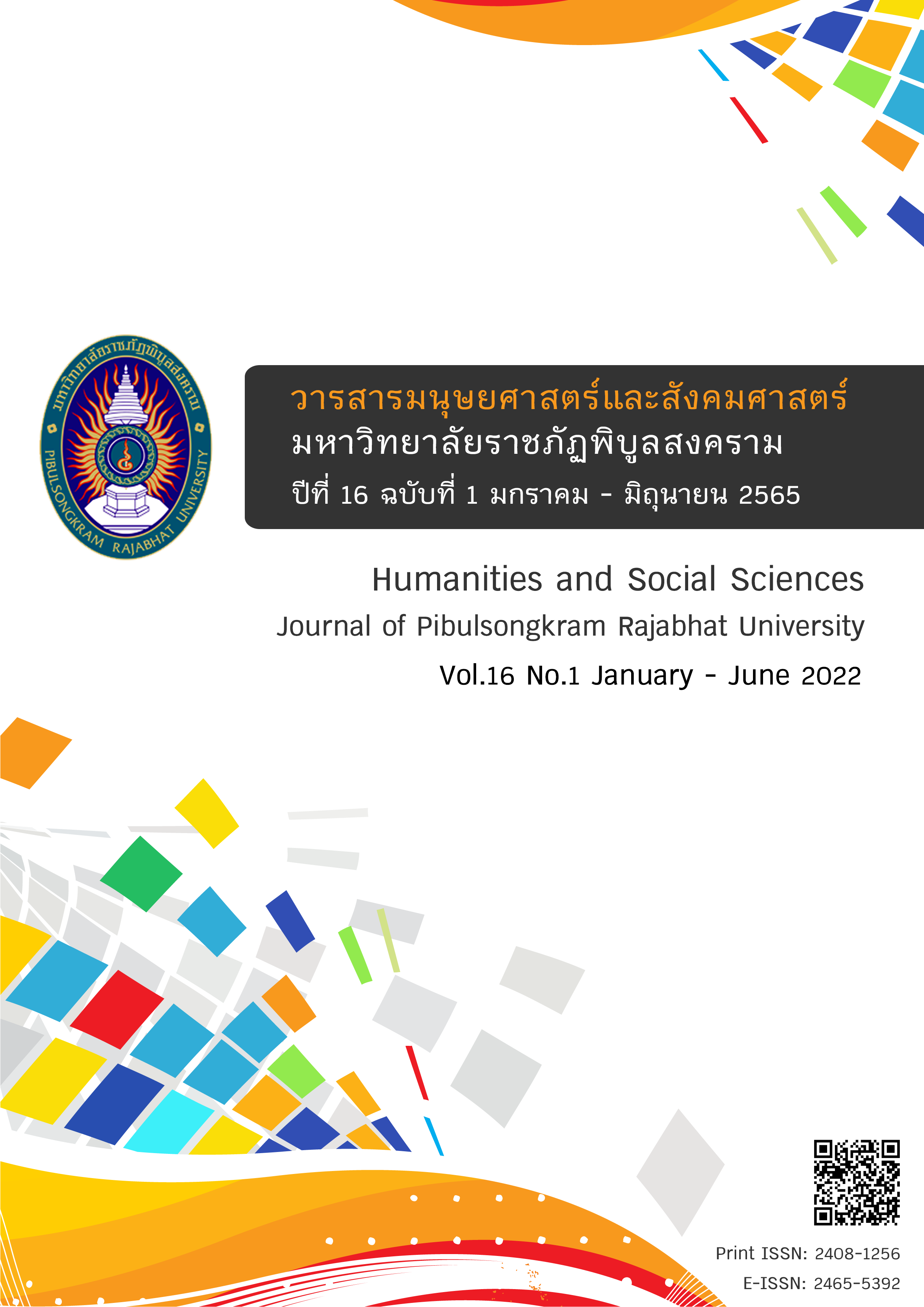ปัจจัยเชิงสาเหตุที่ส่งผลต่อความได้เปรียบในการแข่งขันของวิสาหกิจขนาดกลางและขนาดย่อมในเขตการค้าชายแดนไทย-ลาว
DOI:
https://doi.org/10.14456/psruhss.2022.15คำสำคัญ:
การมุ่งเน้นความเป็นผู้ประกอบการ , ความสามารถทางด้านการตลาด , ความสามารถทางนวัตกรรม , ความได้เปรียบในการแข่งขัน วิสาหกิจขนาดกลางและขนาดย่อม เขตการค้าชายแดนไทย-ลาวบทคัดย่อ
การวิจัยมีวัตถุประสงค์เพื่อศึกษาความสัมพันธ์เชิงสาเหตุของปัจจัยที่ส่งผลต่อความได้เปรียบในการแข่งขันของวิสาหกิจขนาดกลางและขนาดย่อมในเขตการค้าชายแดนไทย-ลาว และเพื่อตรวจสอบ
ความสอดคล้องของตัวแปรเชิงสาเหตุที่มีส่งผลต่อความได้เปรียบในการแข่งขันของวิสาหกิจขนาดกลางและขนาดย่อมในเขตการค้าชายแดนไทย-ลาว โดยใช้แบบสอบถามเป็นเครื่องมือในการเก็บรวบรวมข้อมูลจากผู้ประกอบการวิสาหกิจขนาดกลางและขนาดย่อมส่งออกในเขตการค้าชายแดนระหว่างไทยและลาว จำนวน
600 คน โดยการสุ่มตัวอย่างแบบหลายขั้นตอน สถิติที่ใช้ในการวิเคราะห์ข้อมูล ได้แก่ ค่าร้อยละ ค่าเฉลี่ย ส่วนเบี่ยงเบนมาตรฐาน และการวิเคราะห์โมเดลสมการโครงสร้าง ผลการวิจัยพบว่า ปัจจัยด้านการมุ่งเน้นความเป็นผู้ประกอบการ และปัจจัยด้านความสามารถทางนวัตกรรมมีผลต่อความได้เปรียบในการแข่งขันของวิสาหกิจขนาดกลางและขนาดย่อมในเขตการค้าชายแดนไทย-ลาว โมเดลความสัมพันธ์เชิงสาเหตุของความได้เปรียบในการแข่งขันของวิสาหกิจขนาดกลางและขนาดย่อมในเขตการค้าชายแดนไทยลาว มีความสอดคล้องกับข้อมูลเชิงประจักษ์ค่าสถิติไค-สแควร์ (c2) เท่ากับ 1324.063 ที่องศาอิสระ (df) เท่ากับ 1315 ค่า P-value เท่ากับ .425 ค่าไค-สแควร์กับระดับองศาอิสระมีค่า (c2) /df เท่ากับ 1.007 ดัชนีวัดความกลมกลืน (CFI) เท่ากับ 1.000 ดัชนีวัดระดับความกลมกลืนเชิงสัมบูรณ์ (GFI) เท่ากับ .934 ดัชนีวัดระดับความกลมกลืนที่ปรับแก้แล้ว (AGFI) เท่ากับ .908 ดัชนีวัดระดับความเหมาะสมพอดีไม่อิงเกณฑ์ (TLI) เท่ากับ 1.00 ดัชนีค่าความคลาดเคลื่อนในการประมาณค่าพารามิเตอร์ (RMSEA) เท่ากับ .003 เมื่อพิจารณาค่าสัมประสิทธิ์การพยากรณ์พบว่า มีค่าสัมประสิทธิ์
การพยากรณ์ระหว่าง .397 - .798 โดยปัจจัยด้านความสามารถทางด้านการตลาด (MC) มีค่าสัมประสิทธิ์
การพยากรณ์มากที่สุด และปัจจัยแฝงแต่ละตัวสามารถพยากรณ์รูปแบบความสัมพันธ์เชิงสาเหตุของปัจจัยที่มี
ผลต่อความได้เปรียบในการแข่งขันของวิสาหกิจขนาดกลางและขนาดย่อมในเขตการค้าชายแดนไทย-ลาว ได้
ร้อยละ 49.3
เอกสารอ้างอิง
กรมส่งเสริมอุตสาหกรรม. (2561). โครงการเสริมสร้างผู้ประกอบการใหม่. สืบค้น 29 พฤษภาคม 2561 จาก, http://ipc8.dip.go.th.
ธานินทร์ ศิลป์จารุ. (2557). การวิจัยและวิเคราะห์ข้อมูลทางสถิติด้วย SPSS และ AMOS (พิมพ์ครั้งที่ 15). กรุงเทพฯ: บิสซิเนสอาร์แอนด์ดี.
พิริยะ ผลพิรุฬห์. (2556). บทบาทของวิสาหกิจขนาดกลางและขนาดย่อมไทยในระบบเศรษฐกิจสร้างสรรค์. วารสารเศรษฐศาสตร์ปริทรรศน์ สถาบันพัฒนศาสตร์, 7(1), 206-250.
เพ็ญสุข เกตุมณี, วรลักษณ์ ลลิตศศิวิมล, สิริลักษณ์ ทองพูน, และกอแก้ว จันทร์กิ่งทอง. (2561). ความได้เปรียบในการแข่งขันของธุรกิจวิสาหกิจขนาดกลางและขนาดย่อม ในยุค Thailand 4.0. วารสารมนุษยศาสตร์และสังคมศาสตร์ มหาวิทยาลัยมหาสารคาม, 37(4), 245-256.
ศูนย์ส่งเสริมการพัฒนาความรู้ตลาดทุน. (2561). การแสวงหาโอกาสทางธุรกิจ. สืบค้น 29 พฤษภาคม 2561 จาก, https://www.set.or.th/th/about/sse/value_p1.html
สำนักส่งเสริมขนาดกลางและขนาดย่อม. (2558). รายงานฉบับสมบูรณ์ โครงการจัดทำมาตรการส่งเสริมและ
เพิ่มศักยภาพวิสาหกิจขนาดกลางและขนาดยอม (SMEs) ในพื้นที่ชายแดน. สืบค้น 24 มกราคม 2559 จาก, http://www.sme.go.th
อุบลวรรณ สุวรรณภูสิทธิ์, อดิลล่า พงศ์ยี่หล่า, และพชิต ชนัตศิริพานิช. (2560). ความสัมพันธ์เชิงสาเหตุ ระหว่างการบริหารกิจกรรมพื้นฐานของห่วงโซ่คุณค่าและความสามารถเชิงนวัตกรรมกับผลการดําเนินงานของกิจการหนึ่งตําบลหนึ่งผลิตภัณฑ์ (โอทอป) กลุ่ม เอ ในประเทศไทย. วารสารเทคโนโลยีอุตสาหกรรม มหาวิทยาลัยราชภัฏอุบลราชธานี, 6(2), 51-62.
Banbury, C. M., & Mitchell, W. (1995). The effect of introducing important incremental innovations on market share and business survival. Strategic management journal, 16(S1), 161-182.
Cronbach, L. J. (1951). Coefficient alpha and the internal structure of tests. psychometrika, 16(3), 297-334.
Damanpour, F. (1991). Organizational innovation: A meta-analysis of effects of determinants and moderators. Academy of management journal, 34(3), 555-590.
Ferreira, J., & Azevedo, S. (2007). Entrepreneurial orientation as a main resource and capability on small firm’s growth (Doctor of Philosophy dissertation), Portugal: University of Beira Interior.
Fornell, C., & Larcker, D. F. (1981). Evaluating structural equation models with unobservable variables and measurement error. Journal of marketing research, 18(1), 39-50.
Grewal, R., & Tansuhaj, P. (2001). Building organizational capabilities for managing economic crisis: The role of market orientation and strategic flexibility. Journal of marketing, 65(2), 67-80.
Hair, J. F., Black, W. C., Babin, B. J., & Anderson, R. E. (2010). Multivariate data analysis (7th Ed.). New Jersey: Prentice Hall.
Hall, W. K. (1980). Survival strategies in a hostile environment. Harvard Business Review, 58(5), 75-85.
Henard, D. H., & Szymanski, D. M. (2001). Why some new products are more successful than others. Journal of marketing Research, 38(3), 362-375.
Hult, G. T. M., Hurley, R. F., & Knight, G. A. (2004). Innovativeness: Its antecedents and impact on business performance. Industrial marketing management, 33(5), 429-438.
Kaleka, A., & Morgan, N. A. (2019). How marketing capabilities and current performance drive strategic intentions in international markets. Industrial Marketing Management, 78, 108-121.
Karabulut, A. T. (2015). Effects of innovation strategy on firm performance: a study conducted on manufacturing firms in Turkey. Procedia-Social and Behavioral Sciences, 195, 1338-1347.
Lee, J. S., & Hsieh, C. J. (2010). A research in relating entrepreneurship, marketing capability, innovative capability and sustained competitive advantage. Journal of Business & Economics Research (JBER), 8(9), 109-120.
Lee, S. M., & Lim, S. (2009). Entrepreneurial orientation and the performance of service business. Service business, 3(1), 1-13.
Lin, Z., & Carley, K. M. (2001). Organizational Design and Adaptation in Response to Crises: Theory and Practice. In D.H. Nagao (Ed.) AoM Best papers Proceeding. Sixty-First Annual Meeting of the Academy of Management (B1-B7). Washington, DC, USA, August 3-8, 2001.
Llonch, J., Rialp, A., & Rialp, J. (2011). Marketing capabilities, enterprise optimization programs and performance in early transition economies: the case of Cuban SOEs. Transformations in Business & Economics, 10(3), 45-71.
Lumpkin, G. T., & Dess, G. G. (1996). Clarifying the entrepreneurial orientation construct and linking it to performance. Academy of management Review, 21(1), 135-172.
Lyon, D. W., Lumpkin, G. T., & Dess, G. G. (2000). Enhancing entrepreneurial orientation research: Operationalizing and measuring a key strategic decision making process. Journal of management, 26(5), 1055-1085.
Man, T. W., Lau, T., & Snape, E. D. (2008). Entrepreneurial competencies and the performance of small and medium enterprises: An investigation through a framework of competitiveness. Journal of Small Business & Entrepreneurship, 21(3), 257-276.
Miller, A., & Dess, G. G. (1993). Assessing Porter's (1980) model in terms of its generalizability, accuracy and simplicity. Journal of management studies, 30(4), 553-585.
Noble, C. H., Sinha, R. K., & Kumar, A. (2002). Market orientation and alternative strategic orientations: a longitudinal assessment of performance implications. Journal of marketing, 66(4), 25-39.
Nunnally, J. C. (1978). Psychometric Theory (2d Ed.). New York: McGraw-Hill.
Onağ, A. O., Tepeci, M., & Başalp, A. A. (2014). Organizational learning capability and its impact on firm innovativeness. Procedia-Social and Behavioral Sciences, 150, 708-717.
Porter, M. E. (1990). The competitive advantage of nations. Competitive Intelligence Review, 1(1), 14-14.
Prajogo, D. I. (2016). The strategic fit between innovation strategies and business environment in delivering business performance. International journal of production Economics, 171, 241-249.
Rovinelli, R. J., & Hambleton, R. K. (1977). On the Use of Content Specialists in the Assessment of Criterion-Referenced Test Item Validity. Dutch Journal of Educational Research, (2), 49-60.
Song, M., Di Benedetto, C. A., & Nason, R. W. (2007). Capabilities and financial performance: The moderating effect of strategic type. Journal of the Academy of Marketing Science, 35(1), 18-34.
Special Report. (2556). การค้าชายแดน..โอกาสที่ไม่ควรมองข้ามกับศักยภาพ SMEs ไทย. สืบค้น 24 มกราคม 2560 จาก, http://thaifranchisedownload.com/dl/group73_6110_20130723110922.pdf
Tan, Q., & Sousa, C. M. (2015). Leveraging marketing capabilities into competitive advantage and export performance. International Marketing Review, 32(1), 78-102.
Wang, C. L. (2008). Entrepreneurial orientation, learning orientation, and firm performance. Entrepreneurship theory and practice, 32(4), 635-657.
Wang, C. L., & Ahmed, P. K. (2004). Organisational Learning: A Critical Review. The Learning Organization, 10(1), 8-17.
Weerawardena, J., O' Cass, A., & Julian, C. (2006). Does industry matter? Examining the role of industry structure and organizational learning in innovation and brand performance. Journal of business research, 59(1), 37-45.
ดาวน์โหลด
เผยแพร่แล้ว
รูปแบบการอ้างอิง
ฉบับ
ประเภทบทความ
สัญญาอนุญาต
ลิขสิทธิ์ (c) 2020 วารสารมนุษยศาสตร์และสังคมศาสตร์ บัณฑิตวิทยาลัย มหาวิทยาลัยราชภัฏพิบูลสงคราม

อนุญาตภายใต้เงื่อนไข Creative Commons Attribution-NonCommercial-NoDerivatives 4.0 International License.
บทความหรือข้อคิดเห็นใดใดที่ปรากฏในวารสารมนุษยศาสตร์และสังคมศาสตร์ มหาวิทยาลัยราชภัฏพิบูลสงครามเป็นวรรณกรรมของผู้เขียน ซึ่งบรรณาธิการไม่จำเป็นต้องเห็นด้วย บทความที่ได้รับการตีพิมพ์เป็นลิขสิทธิ์ของวารสารมนุษยศาสตร์และสังคมศาสตร์ มหาวิทยาลัยราชภัฏพิบูลสงคราม









